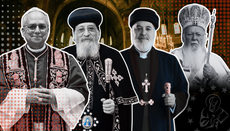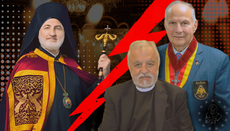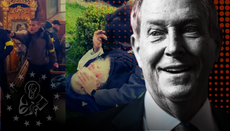Reflections of Cyprus
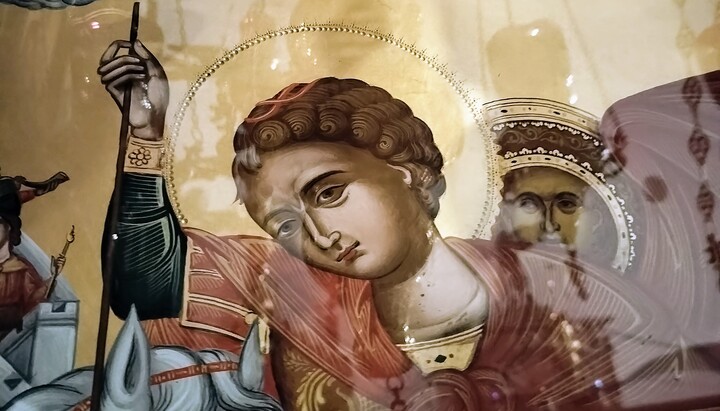
First Days in Cyprus, Rededication of the St. George Nikoxylitis Monastery
Originally posted on Where the Wasteland Ends
The following is an abbreviated version of an article I posted on Substack about my recent pilgrimage to Cyprus. It covers the first few days of the trip—a sort of warmup to deeper reflections which occurred throughout the trip. Future installments will appear there as well.
Introduction
Last Friday (March 9, 2025) I returned from a ten-day trip to the island of Cyprus. I had read quite a bit about Cyprus over the years: its role during the Byzantine Era, the Crusader occupation, the ministry of St. Barnabas the Apostle and others. All of these little bits of history made the idea of visiting the island both interesting and exciting. Before departing I outlined a few places I would really like to see while there; having been baptized on Lazarus Saturday, visiting the tomb of Lazarus was high on the list.
Now, I’m the type of person who doesn’t like to have a strict itinerary—much to the dismay of my highly structured, long-suffering wife. I prefer to have an idea of what I’d like to see when I travel, but to go with the flow, walk the streets, speak with strangers, and see where things go.
It should come as no surprise then that my trip took its own path—to its benefit. My hosts, the places we visited, the people of Cyprus more broadly, and the profoundness of the experience, spiritually, so wildly exceeded my expectations that—if I’m being honest—sitting down to put my thoughts on paper has been rather challenging. It’s not that there isn’t a clear timeline of events, locations, et al… which could be easily outlined, that is certainly the case. But the trip was so rich in spiritual experience and revelation, in historical and cultural immersion, in Christian love and kindness, that the last 35 years have not quite equipped me to express it all clearly.
)to clarify the beginning of the next paragraph without adding the long introduction, American Airlines lost my luggage.)
Day 01: Introduction to Paphos
Tired, with a dead phone and computer and no luggage, I set out the next morning for the mall to grab a local sim card, charger adapters, and a few essentials.
As I was walking through the quiet streets of Paphos, I suddenly smelled incense. I looked around and saw an old church surrounded by a well-maintained garden. The sign read Agios Antonios—St. Anthony the Great.
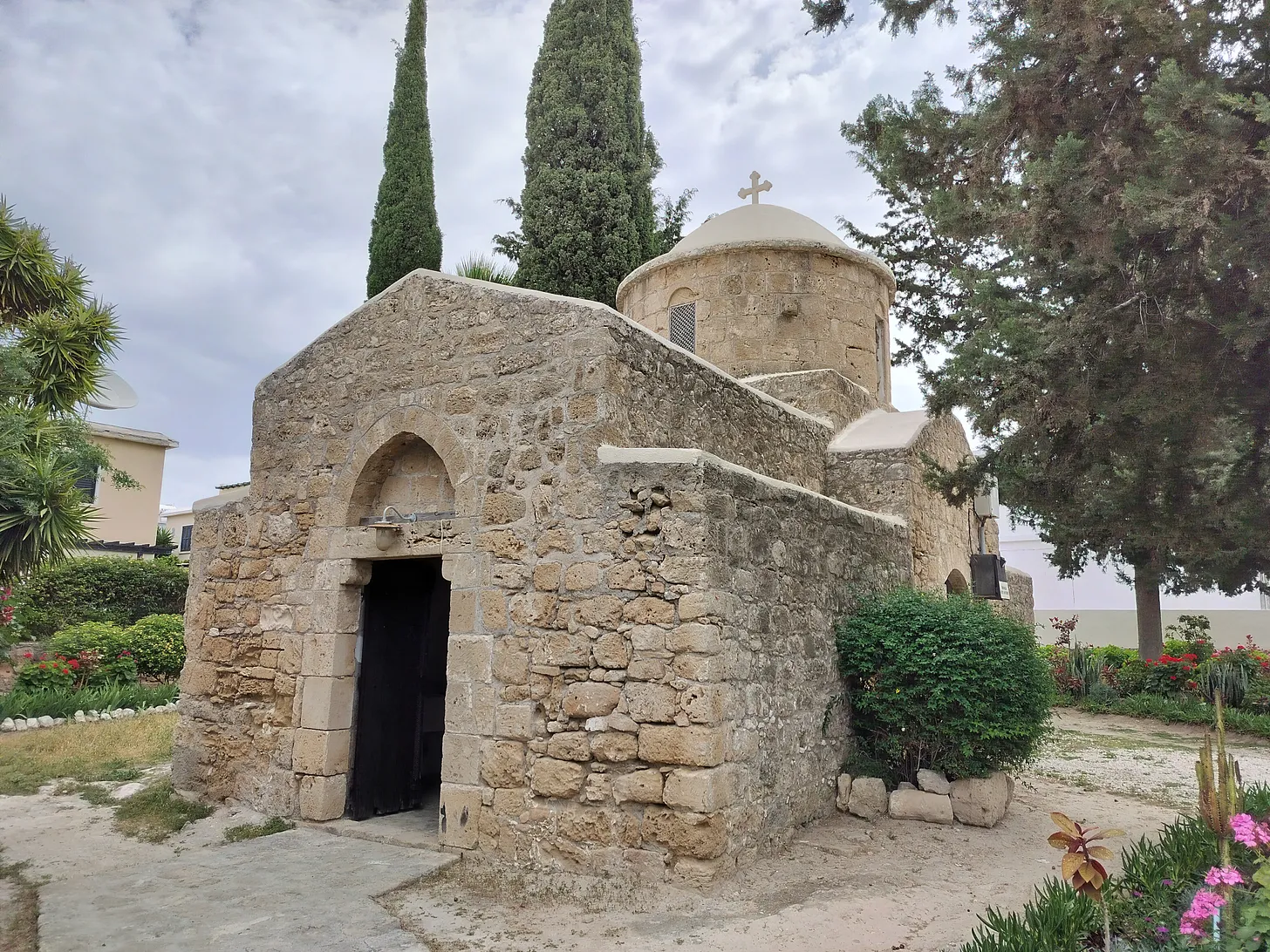
I walked into the garden towards the Church where I was met by a middle-aged Cypriot woman who looked at me with the look of “great, another tourist.” I greeted her with the paschal greeting, and her countenance brightened. With a smile she responded, “Alethos Anesti.”
The Church was old—though it’s hard to tell exactly how old things are in Cyprus—and doesn’t appear to be in liturgical use. Nonetheless, I walked in and lit a candle, thanking God for a safe journey. Having been baptized in another of St. Anthony’s churches, I thanked him for watching over me and granting me a moment to remember God’s providence and care.
This little moment energized me in a way sleep simply could not; after taking some photos, I continued on my journey. One thing I quickly discovered and came to love about Cyprus was something which Fr. Peter Heers had spoken of in his lecture at the Philip Ludwell Fellowship Conference last year in Lockhart, TX: in the 'old country,' there’s a church, a chapel, a shrine, every few blocks in every direction. Everywhere I went, there was somewhere to stop and pray, to light a candle, and just reflect on things.
As I continued on my way to the mall, I stumbled upon an old catacomb/cave church and a series of monastic cells.
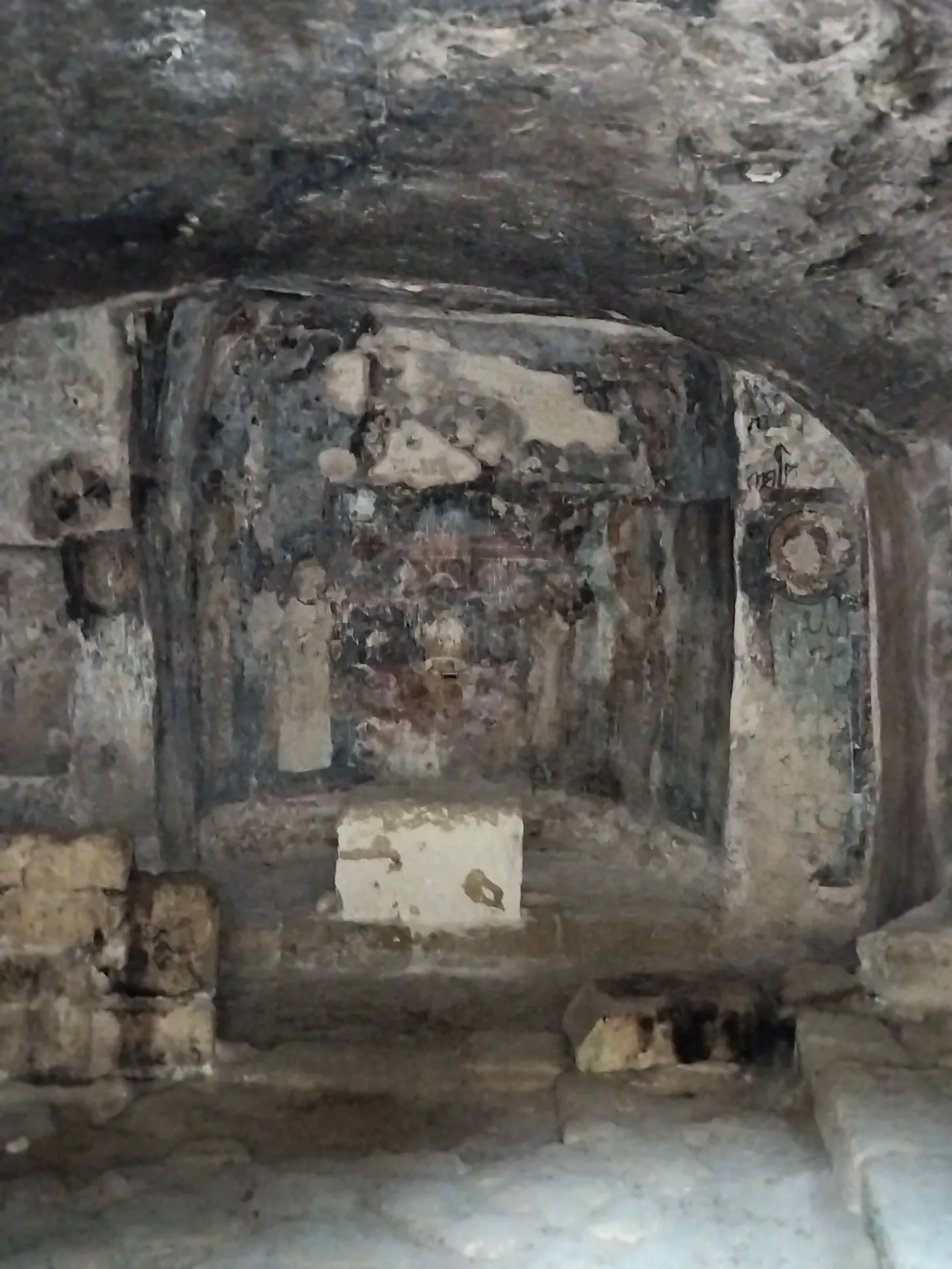
...
Just before departing for dinner, one of the priests, Fr. Alexander, relayed that an ancient monastery was being rededicated the following evening; the Metropolitan of Paphos had invited him and friends and that invitation was extended to me.
Day 02: The Monastery of St. George
The monastery itself has an interesting story. It is believed that the Monastery of Saint George Nikoxylitis (Greek: Άγιος Γεώργιος Νικοξυλίτης) dates back to sometime around the ninth century, built upon the foundations of an earlier monastery to St. George which was abandoned during the Arab invasions.
During the Venetian period, the monastery became fabulously wealthy—one of the wealthiest monasteries on the island for a time. This remained the case until the monastery’s decline began in 1808. The Turks kidnapped Cyprus’s bishops, demanding a massive ransom of the population to have them released. The wealthier monasteries and churches of the island came together to sell large swaths of property to secure the release of the bishops. The St. George Nikoxylitis monastery sold a large portion of its land and assets, shining forth as a beacon of Christian charity and monastic detachment from earthly goods.
A fire struck the monastery in 1923, leaving only the church of St. George, itself damaged by devastating earthquakes in the 1950s. It has sat vacant for decades, its modest structure obscuring the massive stature which it used to hold amongst the Cypriot people.
But two years ago, the saintly Metropolitan of Paphos, His Eminence Tychicus, set out to renovate and reopen the monastery. By God’s providence, I was witness to this momentous occasion.
We set out mid-afternoon for the monastery, through medieval city streets and winding mountain roads.
Arriving around 5:00pm, the property was already packed. We walked to the outer buildings, where there was a little shop set up with various wares, then made our way to the Church. It was fairly small, simple and beautiful. The new wood iconostasis was covered in beautiful carvings and new icons. Above the episcopal throne was an old cross set in the wall. Someone told us that this was uncovered during excavations and is believed to be original—or close to it.
As we walked outside, we got a call to come out to the road. The Metropolitan had just arrived, and they wanted to introduce us. “He is considered a living saint. You will meet him.”
The Rededication
We walked to the road, and Met. Tychicus was standing in the middle of the road with many of the clergy—who were preparing for the arrival of the relics of Saint George. I was ushered over to him and received a blessing. Then there was this somewhat awkward moment where I wanted to ask him a question, then it occurred to me that he might not speak English. Not knowing what to do I just stood there awkwardly for a moment before Fr. Alexander grabbed me and ushered me away. We all got a laugh out of this later.

Shortly thereafter, the relics arrived, and we walked in procession to the Church.
As the Metropolitan and clergy coalesced around the front door, chanting the Paschal troparion, Fr. Alexander came and grabbed me by the arm and dragged me through the crowd until all that was between the Metropolitan and I, were the priests we were with.
After performing the Blessing of the Waters, Met. Tychicus took his staff and knocked on the door three times, with the final knock it started to open and slammed shut. “Lift up your gates ye princes and be ye lifted up ye everlasting gates and the King of Glory shall enter in!” This was, of course, in Greek, but what was occurring was clear. From the other side of the door came “who is this King of Glory?” The Metropolitan continued, and as the verses came to an end, the door was flung open. Father Alexander again dragged me through the crowd of yiayias flooding the doors, and we entered behind Met. Tychicus and the relics of St. George.
Thus began the services of the evening. Having started at about 6:00pm, we moved forward to the All-Night Vigil and Divine Liturgy, which came to an end just before 3:30am.
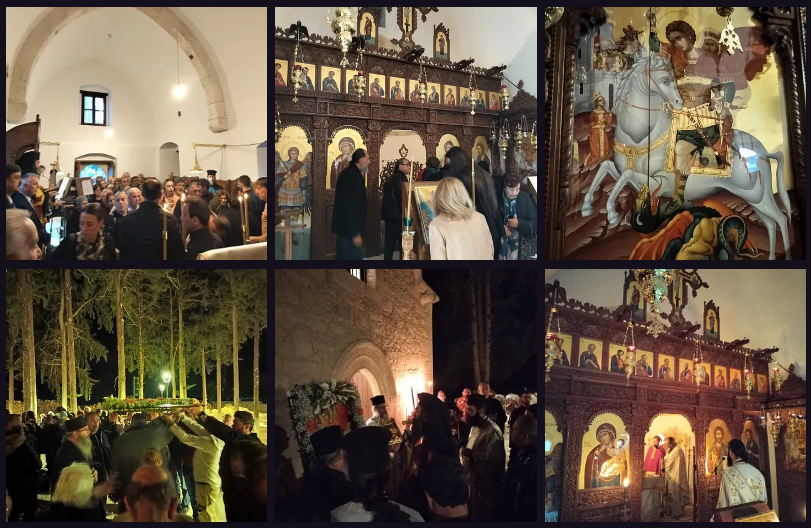
The chanters were the real stars of the evening, both for their skill and endurance—these were long services. At least in the States, Byzantine chant is often poorly done. I’ve often seen where parishes will try to implement some sort of multi-part harmony with the chant, or amateur female chanters will try to join professionally trained male chanters and it rarely turns out well. All of this leads to a poor experience. But in Cyprus, particularly at these services, the Byzantine chant was really well done, both beautiful and edifying.
Father Alexander had placed me under the icon, or as he put it, under the protection of Saint George. Saint George would end up playing a prominent role in the whole trip, and here under his icon in his ancient monastery, I felt very much that he was present and guiding our steps along the way.
As the sun set and the many candles and vigil lamps took on the majority of the work of illuminating the temple, the atmosphere became increasingly prayerful. The sanctity of this place, hallowed by more than a thousand years of prayers and offerings, seemed to seep from every crack and crevice. The gentil light of the lamps reflected off the gold leaf of the icons, bathing everything in a warm glow. Metropolitan Tychicus often seemed to be looking off into another world, his gaze focused long beyond the bounds of the small temple. It gave me the distinct feeling that, unbeknownst to many of us, the angels had truly joined us in the temple—and His Eminence could see them. In an environment such as this, knowing Greek was simply unnecessary; it seemed that our souls simply understood what our ears could not.
As the night dragged on small groups would form outside the church as people rested their legs and spoke about the event before returning to the service. What surprised me was just how many stayed to the end of the service, and how many elderly couples—and even teenagers—stayed through to the end. Nor were Cypriots the only Orthodox people in attendance either. There’s a sizable Ukrainian diaspora in Cyprus, and these were well represented at the service.
Around midnight, there was a procession around the church, in which all walked under the ancient icon of St. George before entering back into the building.
As the service came to a close, we all filed out of the temple. In the outbuildings to the side of the Church, the women had prepared Cypriot Coffee, Baklava, and other treats. We met Metropolitan Tychicus again on the path to the outbuildings; he gave us each his blessing again and seemed genuinely overjoyed that we had come with the Ukrainian clergy who invited us. Someone asked if we could get a photo, and several of us took a photo with Vladyka.
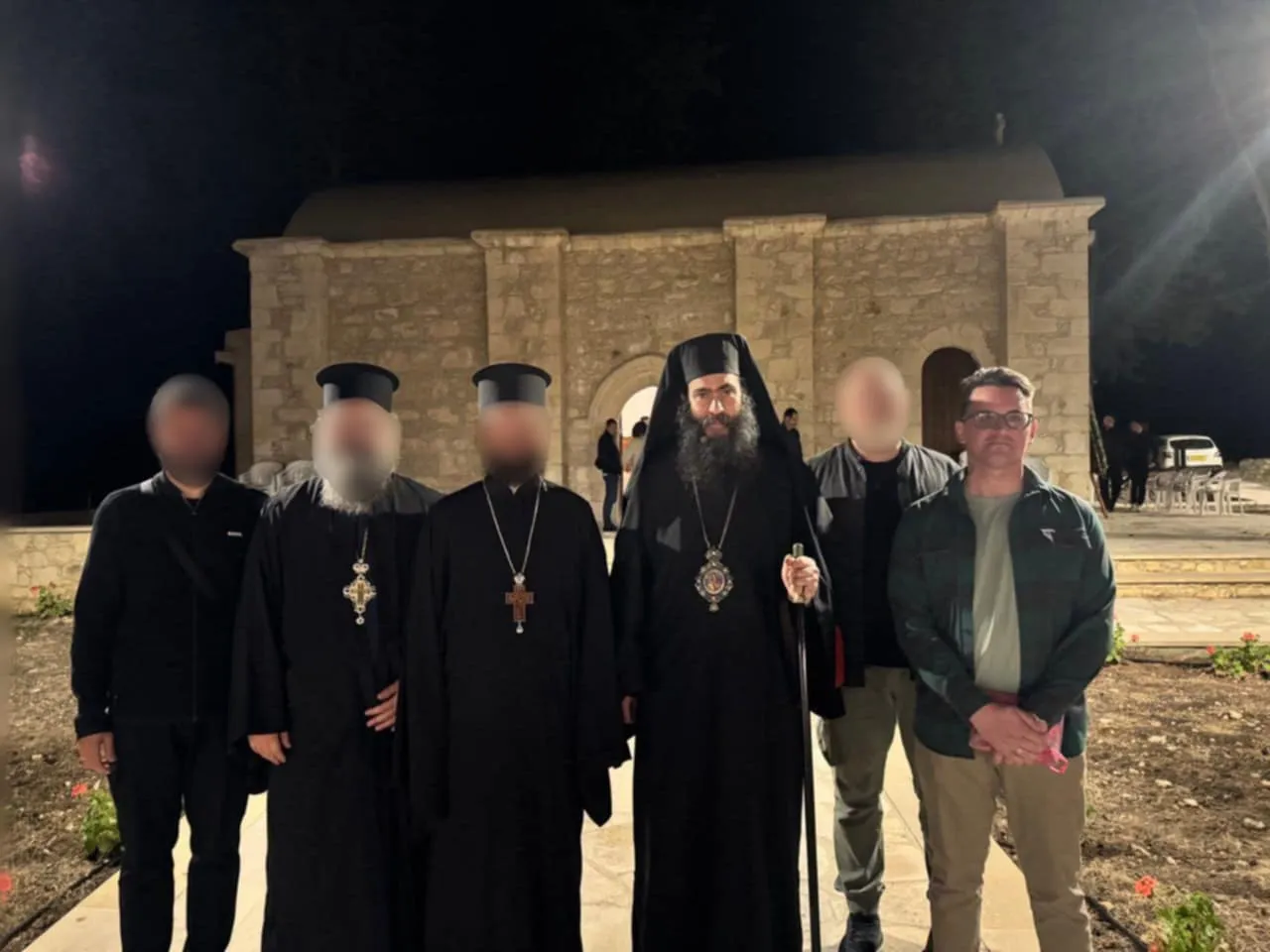
We then entered the outbuilding and grabbed our little disposable cups and plates. Metropolitan Tychicus sat with everyone on the low benches along the walls. The Ukrainians and Russians especially appreciated this. Anyone familiar with the Russian Church knows that when a bishop—especially a Metropolitan—comes to our parishes it's a major affair. We roll out the red carpet and the fine china. But Metropolitan Tychicus sat there with the rest of us, enjoying the simple pleasure of coffee and sweet treats after a long fast and service. Rising from the bench, he prayed for everyone and departed. We were not far behind him. We bid farewell to our friends and began the hour-long drive back to the hotel in Paphos. I arrived sometime around 4:30am. The lights were off and not a soul was found in the lobby. I made my way to my room, thanked God and St. George for the blessing of this experience and quickly fell asleep.
Conclusion
As much as I have written here, it pales in comparison to the experience itself, and there is so much more to say. One thing I hope to touch on in future installments is the oneness of mind which prevailed amongst our party, in spite of the language barrier. Very often, much was communicated without words; often we would look at one another and know exactly what the other was thinking, confirmed by a saying which rang out continuously: Slava Bogu.
Or in English: Glory to God.
One thing I hope readers walk away from this series with is the absolute necessity of going on pilgrimage. In Western spirituality, the practice of pilgrimage has been all but forgotten. Those who do participate in it, do so just as they would visiting a battlefield or other historical attraction. I’m not saying you can’t take pictures—you should, use them to entice friends to do the same—but pilgrimage is more than tourism. It’s an expression of love for God, for the saint to whose shrine you travel; it’s an offering to God; it is an asceticism and form of repentance, a way by which we honor God and His saints. Is a family member sick? Travel to the Holy places, make your prayers and offerings there, the Lord will bless you.
Something which struck me was just how palpably I could feel the sanctity of the places I went. You could feel the effects of the centuries and centuries of prayers which had hallowed the very ground you walked on, the air you breathed. A thought entered my mind: what if America had such places? From this, a prayer spontaneously burst forth from my lips: God, grant that we may cover our land in shrines and places of prayer, that we may sanctify the ground from which we are raised and onto which we will return, to Thy Glory. Amen.

